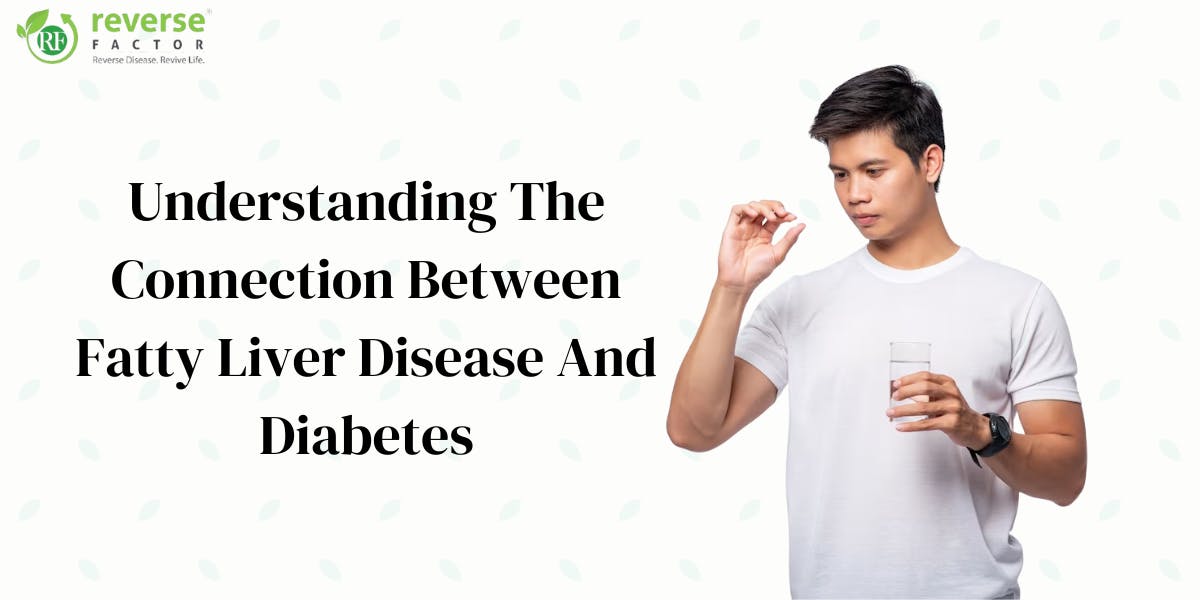In recent years, our country has seen a sudden rise in cases of fatty liver disease. Fatty liver disease and diabetes are closely linked, as they can contribute to the development of one another. When the liver becomes overloaded with fat, it can become inflamed and damaged. It can lead to the development of non-alcoholic fatty liver disease (NAFLD). NAFLD is more common in people with type 2 diabetes.
Diabetes, on the other hand, can cause insulin resistance, which can make it more difficult for the body to process fats and sugars. This can increase the risk of developing fatty liver disease and may worsen existing liver damage. Fortunately, you can reverse the condition by joining a trusted diabetes reversal program in India.
Therefore, you must pay attention to its symptoms and take steps to manage both conditions to maintain optimal health.
Let’s try to know about diabetes and liver disease symptoms, their causes, risk factors, and how to manage both conditions.
Recommended: The Best Foods For Kidney Health That You Haven't Heard Of!
What Is Fatty Liver Disease?
Fatty liver disease is also known as hepatic steatosis. It is a condition that occurs when excess fat accumulates in the liver, leading to inflammation and scarring. It is a common disorder and can lead to serious complications if left untreated. This disease is divided into two types which are as follows-
1. Alcoholic fatty liver disease
This condition occurs in those people who consume excessive amounts of alcohol.
2. Non-alcoholic fatty liver disease
It happens to those who do not drink excessive amounts of alcohol. This type of fatty liver causes diabetes.
If you underwent any of these conditions you must opt for fatty liver disease reversal program to gain control over your health.

Must Read: India's Top 13 Fatty Liver Home Remedies That Work Fast
What Are the Causes Of Fatty Liver Disease In Individuals Living With Diabetes?
People living with diabetes are at increased risk of developing the non-alcoholic fatty liver disease (NAFLD). One of the main causes of NAFLD is insulin resistance, which is a hallmark of type 2 diabetes. Insulin resistance occurs when the body's cells become less responsive to insulin. It can cause the pancreas to produce more insulin to compensate. This excess insulin can cause the liver to produce more fat and reduce its ability to break down fat, which builds up excessive fat in the liver. Another important risk factor for NAFLD is obesity. Excess body fat can contribute to insulin resistance and increase the risk of NAFLD. Losing weight and incorporating a diabetes reversal diet plan in your daily life can help you control your blood sugar. High blood pressure and cholesterol levels are also associated with the risk of developing NAFLD.
Studies show that consuming sugary drinks and processed food is also associated with the development of NAFLD. So, you must strictly follow a diabetes and fatty liver diet to stay healthy and fit. Plant–based food like green vegetables and fruits are an important part of fatty liver reversal program. As it reduces the risk of development and progression of NAFLD.
Read More: Promote Your Health With An Indian Diet Chart for Diabetic Patient
Symptoms Of Fatty Liver And Diabetes
Oftentimes, there may be no symptoms of NAFLD at all, especially in the early stages. Here are some of the most common symptoms associated with diabetes and liver disease that you can experience in the advanced stage:
Symptoms of Fatty Liver:
- Extreme Fatigue
- Abdominal pain or discomfort
- Enlarged liver
- Jaundice (yellowing of the skin and eyes)
- Swelling in the legs and ankles
- Elevated liver enzymes
- Poor appetite
- Unexplained weight loss
- Nausea and vomiting
Symptoms of Diabetes:
- Frequent urination
- Excessive thirst
- Blurred vision
- Slow healing of wounds or cuts
- Numbness or tingling in the hands and feet
- Fatigue
- Unexplained weight loss
- Increased hunger
- Dry mouth
- Skin infections
Many of these symptoms can be caused by other conditions as well. In some cases, people living with fatty liver or diabetes may not experience any symptoms at all. Therefore, it is important to consult a certified health expert if you experience any unusual symptoms.
What Is The Healthiest Fatty Liver And Diabetes Diet?
The best way to manage your weight and reverse both conditions is to consume a plant-based diet. Consider adding more food to your diet listed below.
Vegetables
Eating a diet rich in vegetables can be beneficial for both fatty liver and diabetes. Vegetables are high in fiber, vitamins, and minerals, and low in calories, which can help with weight management. The high fiber content in vegetables can help reduce blood sugar levels and improve insulin sensitivity. The antioxidants and anti-inflammatory properties of vegetables can protect the liver from damage. So, you must include leafy greens, cruciferous vegetables, and colorful vegetables in your diet. It will help you to improve liver function and blood sugar control.

Fruits
Fruits are a good source of fiber, vitamins, minerals, and antioxidants. Consuming fruits can help reduce the risk of developing chronic diseases like diabetes and fatty liver disease. Fruits have a lower glycemic index which can help stabilize blood sugar levels and reduce insulin resistance. Fruits like bananas, apples, and grapes have been shown to improve liver function and reduce inflammation. These fruits are also good for blood sugar control. However, you must consume them in moderate amounts by consulting your dietician or doctor.

Lentils And Legumes
Lentils and legumes are a great addition to a fatty liver treatment diet. They can help you control blood sugar levels and prevent the progression of fatty liver disease. Lentils and legumes are low on the glycemic index, and rich in fiber and protein. Both of these can help control blood sugar levels, and support weight management. The high fiber content of these foods can also help reduce the absorption of cholesterol in the gut, which can help lower the risk of developing fatty liver disease. Moreover, including lentils and legumes in your Indian diet can be very easy.

Nuts
Nuts are the most popular food item in India consumed by all age groups. Consuming a handful of nuts can be a great option for those living with fatty liver diabetes. Nuts are a good source of healthy fats, protein, fiber, vitamins, and minerals. It can help improve your blood sugar, reduce inflammation, and protect liver function. Research has shown that consuming nuts may help improve insulin sensitivity and decrease the risk of developing type 2 diabetes.

Whole Grains
Whole grains are rich in fiber, vitamins, and minerals, and have a lower glycemic index compared to refined grains. Hence, it is a better choice for blood sugar control. The high fiber content of whole grains can help in weight management. Whole grains have also been shown to reduce inflammation and improve insulin sensitivity. It can help protect against the development and progression of fatty liver disease.

Final Thoughts
NAFLD affects around 9% to 53% of the general population in India with type 2 diabetes. Therefore, it is important to understand the connection between fatty liver disease and diabetes. People with diabetes are at an increased risk of developing fatty liver disease. However, there are lifestyle changes you can make to help prevent and manage both conditions. Incorporating a diet rich in vegetables, fruits, legumes, nuts, and whole grains can support liver function and manage blood sugar levels. Regular exercise and weight management can also help reduce the risk of developing these conditions. Making these changes can help improve your quality of life and reduce your risk of developing serious complications.
Frequently Asked Questions -
Does Fatty Liver Cause Diabetes?
Yes. There is a strong link between diabetes and liver disease. Non-alcoholic fatty liver disease is strongly associated with obesity and insulin resistance which are risk factors for type 2 diabetes.
How Does Diabetes Cause Fatty Liver?
Type 2 diabetes can lead to the development of fatty liver through the excessive production and release of glucose by the liver. It can lead to insulin resistance and fat accumulation in the liver.
How Does Fatty Liver Affect Blood Sugar?
Fatty liver can affect blood sugar levels by contributing to insulin resistance, which can lead to high blood sugar levels. Insulin resistance occurs when the body's cells do not respond properly to insulin. As a result, the liver may continue to produce glucose, leading to high blood sugar levels.
Is Diabetic Fatty Liver Reversible?
Yes. Diabetes fatty liver can be reversed through lifestyle changes such as weight loss, healthy eating habits, and regular exercise.
Why Does Fatty Liver Occur In Diabetes?
Fatty liver occurs in diabetes due to insulin resistance. It can cause the liver to produce excess glucose and triglycerides. This excess production of triglycerides can lead to fat accumulation in the liver, resulting in fatty liver disease.
Can Liver Problems Cause Diabetes?
Yes. Liver problems like Non-alcoholic fatty liver disease can lead to the development of diabetes.




